The roof is a rather complicated structure. Includes flooring that protects the house from rain and snow, insulation, vapor barrier and waterproofing. Roofing material is most often used as the latter.
Features of the roof structure
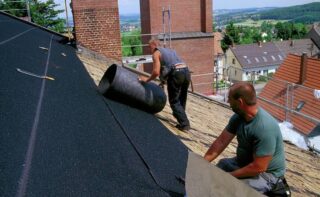
In summer cottages, the attic most often turns into an attic. Regardless of whether it will be a heated room or only a summer one, the roof must be insulated. This design includes the following layers:
- Basic frame - it is a rafter system made of wooden beams.
- Vapor barrier - the film is fixed on the rafters from below. If we are talking about an attic, a finishing flooring can be attached to the vapor barrier.
- Insulation - heat-insulating material, like mineral wool or basalt wool mats, is placed between the rafters. Umbrella dowels are used for fixing.
- Waterproofing - most often in this case, roofing material is laid. The material is impervious to moisture, not afraid of significant temperature changes, resistant to mechanical damage, as it has high elasticity. Waterproofing protects the insulation from moisture ingress.
- Lathing - you cannot put the roofing material directly on the waterproofing. On top of the structure, a crate is installed - lattice or solid, which is determined by the nature of the flooring.
- Roofing - slate, ondulin, soft tiles, ceramic tiles and more. The laying technology of different materials differs.
Roofing material is in demand in almost all construction work related to the waterproofing of any part of the structure. To prevent water from rising up the walls from wet soil, it is necessary to waterproof the foundation. This is done using several layers of material.
Roofing material can also serve as a roofing material. This option is used on flat concrete roofs with a very low angle of inclination.
Styling technique
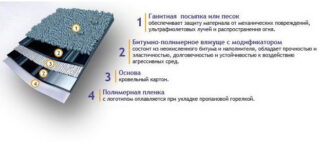
Roofing material is a laminated material based on roofing cardboard and bitumen. Petroleum bitumen is applied to both sides of the cardboard and then sprinkled with grit. By the type of sprinkling, roofing material is divided into several categories.
- Coarse-grained - made from stone chips. A universal option suitable for waterproofing roofs and foundations.
- Scaly - a crumb of mica slate. Recommended for roof decking.
- Fine-grained - sand serves as a dressing. It is used as a lining in a roofing cake or as a top coat.
- Dusty - talcum powder or chalk serves as a dusting. Such roofing material is soft and elastic; it is used as a lining material.
For installation on the roof, it is recommended to take a coarse-grained roofing material with colored dusting. It reflects sunlight better than gray or black coated sheets.
Roofing material is laid in different ways. It depends on the purpose of the material, roof structure, foundation or wall.
Laying roofing material in several layers
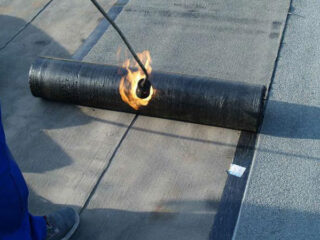
The need for such installation usually arises when waterproofing concrete flat roofs. The angle of the slope in this case is minimal; roofing materials like tiles, slate or ondulin are not suitable for finishing it.
Most often, work is performed on glue - strips of material are laid, gluing them together.The first layer can be applied by hot method - on bitumen mastic.
The main task of multilayer masonry is to achieve a snug fit of the material. This improves the weather resistance of the roof. To do this, take the material sprinkled with crumbs on one side.
First, fine-grained roofing material is laid, as it sticks together better. The strips are overlapped by 8-10 cm. This part of the strip should be lubricated with glue more generously. It is better to first remove the layer of powder from this fragment. The last layer is coarse-grained or scaly roofing material, since the coarser, rough material provides the roof with greater resistance to wind and snow.
When the concrete roof is covered, the roofing material is placed with the powder side up.
How to choose the number of layers
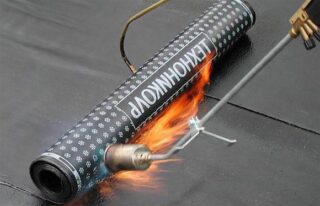
The number of layers determines the slope of the roof or the waterproofing requirements of the structure. The thickness of the material is also taken into account: 1 layer of euroruberoid replaces 2 layers of the usual one.
- On a slope with an angle of inclination of 45 degrees, roofing material is laid in 2 layers. A bedding layer without powder is laid down on the bitumen, and a coarse-grained roofing material with colored chips is laid on top.
- If the slope is less - 20-40 degrees, 3 layers are laid: 2 bedding, 1 with stone chips. Otherwise, the roof will last no more than 2 years.
- With a slope of up to 15 degrees, 4 layers of material will be required for waterproofing. With such a low angle, moisture and snow are trapped on the roof, which increases the risk of leakage.
- On flat roofs, the waterproofing is 5 layers. In this case, strips of roofing material are laid perpendicular to each other in order to increase the overlap area.
With a small slope, it is recommended to use a self-leveling roofing material. It is applied cold, but at the same time ensures maximum uniform distribution.
How to lay roofing material on a concrete roof
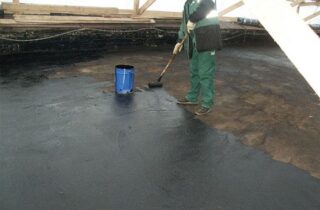
It is recommended to glue roofing material on a concrete roof using the cold method. The step-by-step instructions are quite simple.
- The base is cleaned of debris and leveled. Close up all joints, irregularities, dents.
- The concrete surface must be completely dry. Work can only be carried out in dry weather. Fog, light rain, moisture on the surface will not allow the material to stick.
- Apply a primer layer of 6 liters of kerosene, 4 liters of bitumen and 1.5 kg of crumbled chalk. The primer binds the loose concrete top layer and improves the adhesion properties.
- The adhesive is applied along the strip. Then the strip is straightened from the center to the edges to avoid the appearance of bubbles, and pressed. The second strip is laid with an overlap of 8-10 cm on the glue layer.
- After 12 hours, a second layer of roofing material is laid.
Self-adhesive material can be used. In this modification, glue is already applied to the roofing material on one side. To glue it, you need to remove the sewn film and press the strip to the surface.
Pitched roof
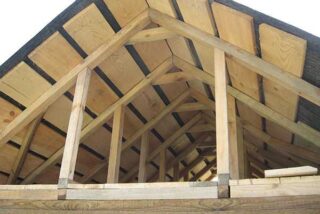
The peculiarity of the pitched roof is a solid lathing. It is carried out from plywood, OSV or chipboard sheets, edged unedged boards. Roofing material should be laid with the sprinkled side up. 3 methods are used.
- Across the slope - the canvas is placed horizontally relative to the edge of the roof, installation starts from the bottom, the next layer is laid with an overlap from above. With this method, water leakage into the seams is excluded.
- Along the slope - the strip is laid, starting from the pediment with an overlap of 10–20 cm. The seams are vertical and even contribute to the drainage of water.
- Composite - the next layer is laid perpendicular to the previous one. Costly method, used for low slope.
The last method is the most difficult when building with your own hands. In this case, the first layer is laid horizontally, wrapping the ends of the sheets under the edge of the roof. The strips are glued, but the fasteners are duplicated with slate nails. Then the slope is coated with bitumen mastic and the second layer is laid along the slope, with an overlap over the ridge. Sheets are additionally fixed with slats.
In case of compound installation, each next layer is laid with an offset of 1/3 or 1/2 strip so that the seams of the previous layer do not coincide with the seams of the next one.
Wooden roof
To cover a wooden roof with roofing material, use the same scheme. If the material acts as a roof, a lattice crate made of wide boards is needed for it. There should be 2 or 3 layers depending on the slope of the slope.
The first one must be placed horizontally on a layer of mastic. Use a lining soft roofing material. The second one should be placed along the slope. If necessary, lay the 3rd layer. For the last top, take a material with a stone powder.
When laying on a wooden roof, the material must be additionally secured with wooden slats.
The use of roofing material during repair work
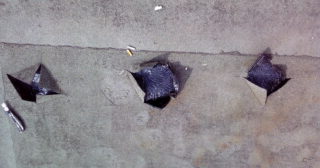
When repairing, it is not necessary to completely remove the damaged coating. Restoring the flooring includes the following sequence of actions.
- The damaged area is cleaned: the torn off fragments are removed, the frayed edges are cut off, the old fasteners are removed. Only whole fragments of the roof should remain.
- Bubbles or bulging, if any, are cut crosswise. Then the incisions are coated with mastic.
- The site is well dried. If the repair is urgent, use a construction hair dryer.
- The bitumen is heated, the area is poured with it, then a canvas is laid with dimensions exceeding the damage by 10–20 cm along the perimeter. If the roof was multi-layer, several layers of material are laid during the repair.
The laying pattern is the same: with the powder side up.
Laying and repairing with roofing felt in winter is performed in the same way as in hot weather. The material does not lose flexibility down to -25 ° C. However, work should only be done in dry weather.
Laying roofing material on the foundation with your own hands
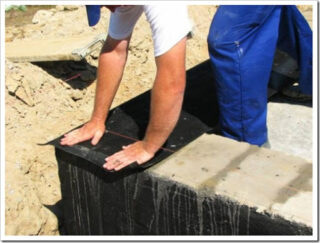
The foundation for the construction of any structure must be waterproofed. It is not difficult to properly lay roofing material on the foundation. For this, take a smooth roll material without sprinkling.
The technology is simple.
- The base is cleaned, leveled, removing the remnants of the solution. The concrete grillage is primed to improve adhesion.
- Apply mastic to the surface in several layers.
- Roofing material sheets are heated with a burner and placed on the mastic. The next fragment is placed with an overlap of 10 cm. The joints are coated with mastic again.
- Waterproofing is recommended to be performed in 2 layers.
If a burner is not at hand, a mastic with high binding characteristics is used for installation. It retains its elasticity for quite a long time, which makes it possible to glue the material more reliably.








